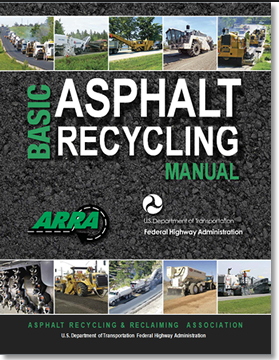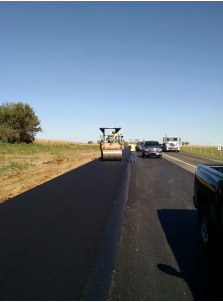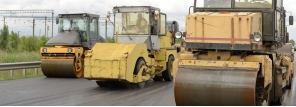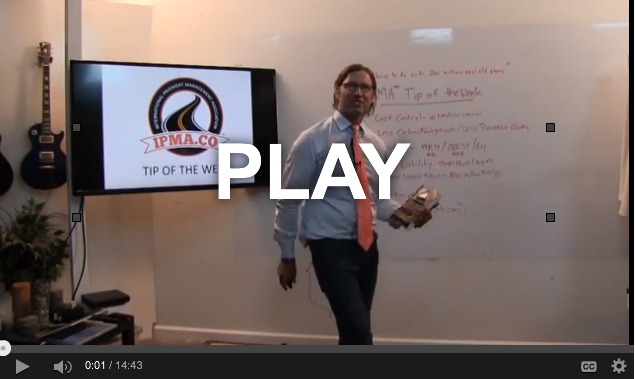What you will learn:
 The growing demand on our nation’s roadways over that past couple of decades, decreasing budgetary funds, and the need to provide a safe, efficient, and cost effective roadway system has led to a dramatic increase in the need to rehabilitate our existing pavements. The last 40 years has also seen a dramatic growth in asphalt recycling and reclaiming as a technically and environmentally preferred way of rehabilitating the existing pavements. Asphalt recycling and reclaiming meets all of our societal goals of providing safe, efficient roadways, while at the same time drastically reducing both the environmental impact and energy (oil) consumption compared to conventional pavement reconstruction.
The growing demand on our nation’s roadways over that past couple of decades, decreasing budgetary funds, and the need to provide a safe, efficient, and cost effective roadway system has led to a dramatic increase in the need to rehabilitate our existing pavements. The last 40 years has also seen a dramatic growth in asphalt recycling and reclaiming as a technically and environmentally preferred way of rehabilitating the existing pavements. Asphalt recycling and reclaiming meets all of our societal goals of providing safe, efficient roadways, while at the same time drastically reducing both the environmental impact and energy (oil) consumption compared to conventional pavement reconstruction.
The Board of Directors of the Asphalt Recycling and Reclaiming Association (ARRA), in their ongoing commitment of enhancing and expanding the use of asphalt recycling and reclaiming, recognized a need for a “Basic Asphalt Recycling Manual”. The manual was needed in order to expose more owners, specifying agencies, consultants, and civil engineering students to the value and current methods of asphalt recycling. To fill that need, this manual was produced to serve as a handy one-stop reference to those starting out in one of the various forms of asphalt recycling. In addition, it is hoped that this manual will provide additional useful information to those already in- volved in asphalt recycling.
This manual is not written in such detail so that one could use it to completely evaluate, design, specify, and/or construct an asphalt recycling project. It does however, provide information on:
• Various asphalt recycling methods
• Benefits and performance of asphalt recycling
• Procedures for evaluation potential projects
• Current mix design philosophies
• Construction equipment requirements and methods
• Quality Control/Quality Assurance, inspection and acceptance techniques
• Specification requirements
• Definitions and terminology
Sufficient information is provided so that a rational decision can be made with respect to the feasibility and/or cost benefits of asphalt recycling. From that point, detailed design issues will need to be addressed by those experienced in asphalt recycling techniques prior to the final project design, advertising, tendering or letting and construction.
The benefits of asphalt recycling include:
• Reuse and conservation of non-renewable natural resources
• Preservation of the environment and reduction in land filling
• Energy conservation
• Reduction in user delays during construction
• Shorter construction periods
• Increased level of traffic safety within construction work zone
• Preservation of existing roadway geometry and clearances
• Corrections to pavement profile and cross-slope
• No disturbance of the subgrade soils unless specifically planned
• Such as for Full Depth Reclamation (FDR)
• Improved pavement smoothness Improved pavement physical properties by mod- ification of existing aggregate gradation, and asphalt binder properties
• Mitigation or elimination of reflective cracking with some methods
• Improved roadway performance
• Cost savings over traditional rehabilitation methods
It is important to recognize that asphalt recycling is a powerful method to rehabilitate pavements. When properly applied, it has long term economic benefits allowing owner agencies to stretch their available funds while providing the traveling public with a safe and reliable driving surface.
It is also important to recognize that, although asphalt recycling technology and methods has advanced, not all roadways are appropriate candidates for asphalt recycling. With the almost endless supply of roadways needing rehabilitation, it would be a dis- service to the public and the industry to use poor judgement in attempting an inappropriate recycling project. Hopefully, with this manual and the advice of those experienced in asphalt recycling, only projects that are suitable candidates will be undertaken.
The primary focus of the manual is on the in-place and cold recycling of asphalt pavements. Hot recycling of asphalt pavements through various types of asphalt plants is a well established recycling method. There is a wide variety of information on the subject available from well established sources and therefore has not been covered in any detail in this manual.
You can order your here:
http://arra-online.myshopify.com/products/basic-asphalt-recycling-manual-2014
And do not forget the FREE BOOK HERE:










